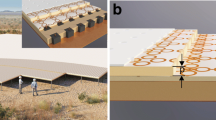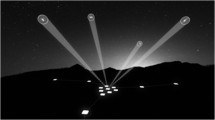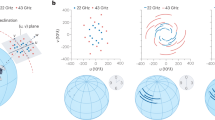Abstract
Investigating the requirements for an aperture synthesis array that optimise the performance for surveying shows that, next to collecting area and system temperature, the field-of-view (FoV) is key parameter. However, the effective sensitivity not only depends on bandwidth and integration time but could be seriously limited by side lobe confusion and by gain errors that determine the effective dynamic range. From the basic sensitivity equation for a radiometric system we derive an optimum cost ratio between collecting area and processing electronics, where the latter should be less than a third of the total cost. For an instrument that has to cover a fraction of sky larger than its field-of-view, the FoV enters the equation for survey sensitivity and we identify the number of independent feed systems per unit collecting area as a key parameter. Then the optimum cost distribution allows the electronics to account for up to half the total cost. Further analysis of the sensitivity formula shows that there is an optimum design frequency for a survey instrument below 1 GHz. We discuss the impact of station size and array configuration on self-calibration, side lobe confusion and effective sensitivity and conclude that a minimum station size of 20 m diameter is required at 0.3 GHz as long as multi-patch self-calibration procedures need, per baseline, a signal-to-noise ratio of more than two for each ionospheric coherence patch.
Similar content being viewed by others
References
Boonstra, A. J. and van der Veen, A. J.: 2003, ‘Gain Calibration Methods for Radio Telescope Arrays’, IEEE Trans. Signal Process. 51(1).
Bregman, J. D.: 1999, ‘Design Concepts for a Sky Noise Limited Low Frequency Array’, Proceedings NFRA Symposium Technologies for Large Antenna Arrays, Dwingeloo, The Netherlands.
Bregman, J. D.: 2000, ‘Concept Design for a Low Frequency Array’, SPIE Proc. Astron. Telescopes Instrum. 4015.
Bunton, J. D.: 2003, ‘Figure of Merit for SKA Survey Speed’, SKA memo 40.
Bunton, J. D., Jackson, C. J. and Sadler, A. M.: 2002, ‘Cylindrical Reflector SKA’, White Paper, SKA Design Concept White Papers 1–7, Eng. Section on http://www.skatelescope.org.
Jones, D. L.: 2004, ‘SKA Science Requirements: Version 2’, SKA memo 45.
Kraus, J. D.: 1988, Antennas, 2nd Edn., ISBN 0-07-100482-3.
Noordam, J. E.: 2001a, ‘LOFAR Calibration and Calibratability’, LOFAR-ASTRON-MEM-001.
Noordam, J. E.: 2001b, ‘Guidelines for the LOFAR Array Configuration’, LOFAR-ASTRON-MEM-002.
Perley, R. A., Schwab, F. R. and Bridle, A. H.: 1994, ‘Synthesis Imaging in Radio Astronomy’, Astronomical Society of the Pacific Conference Series 6, ISBN 0-937707-23-6.
Author information
Authors and Affiliations
Corresponding author
Rights and permissions
About this article
Cite this article
Bregman, J.D. System Optimisation Of Multi-Beam Aperture Synthesis Arrays For Survey Performance. Exp Astron 17, 365–380 (2004). https://doi.org/10.1007/s10686-005-2872-8
Received:
Accepted:
Issue Date:
DOI: https://doi.org/10.1007/s10686-005-2872-8




